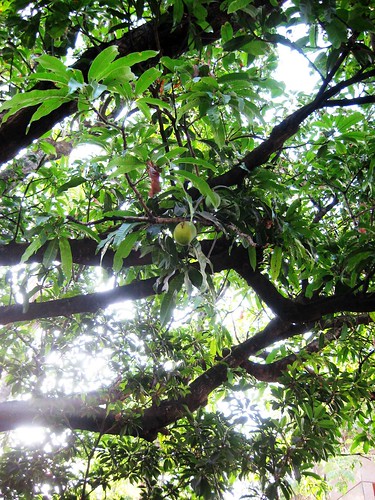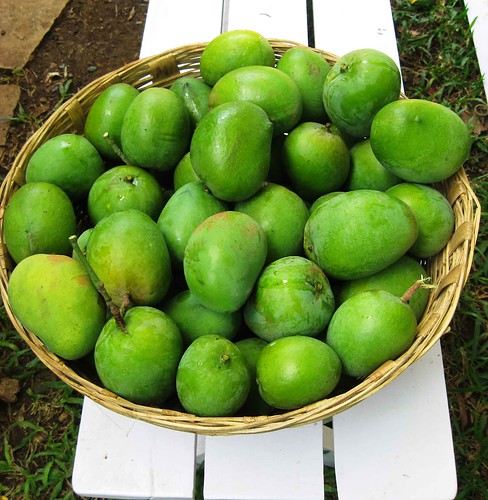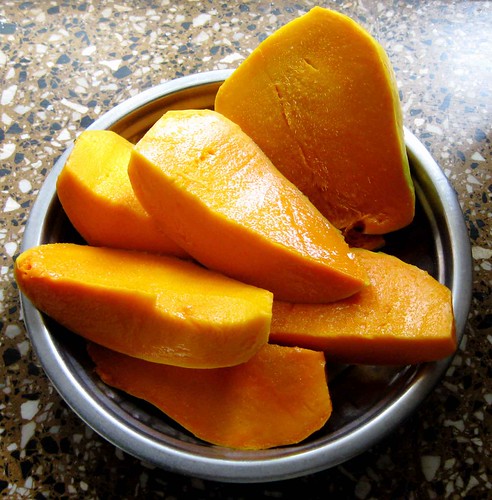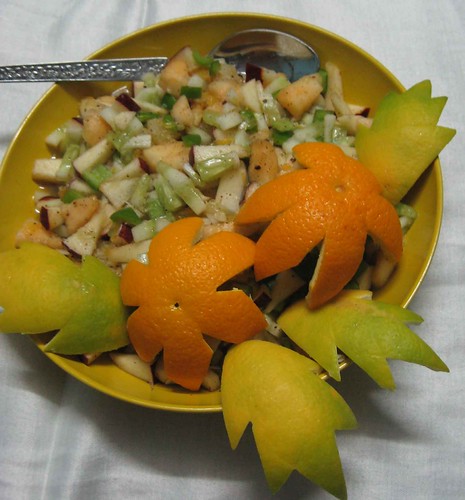There is one lone mango tree in my parents' backyard but it is an old, ample and generous soul that manages to keep us well-supplied with prized alphonso (hapoos) mangoes throughout the mango season. The bright summer sun filtering through the dense mango leaves is a beautiful sight.
It is almost the end of the mango season but two days ago, there was still a lot of fruit hanging off the tree, ready to be picked.
Picking mangoes off such a huge tree without injuring the mangoes (by dropping and bruising them) and without damaging the tree is an art in itself. My Dad fashioned this low-tech device that works beautifully. Atop a bamboo stick, there are two blades and below them is a sack. The blades lop off the mango right at the stem and it falls into the basket.
Mangoes are picked when they are still green and they ripen indoors after picking. If you leave them on the tree to ripen, the birds and monkeys will beat you to it! Trust me, even after picking the mangoes, there are plenty left over in the upper branches for these critters.
After picking comes the sorting. The smaller kairis (raw or semi-ripe mangoes) are set aside for making panha (a beverage) or chhunda (a sweet-spicy-tangy preserve of shredded mangoes). Then the chosen fruits are nestled gently in straw beds where they ripen over several days. I share the room where the mangoes are kept and enjoy the heady fragrance of ripening mangoes as I drift off to sleep and as I wake up. The straw is a wonderful incubator for the ripening mangoes. You pick one up from its straw bed and it is incredibly warm to the touch. You can feel the metabolism burning and transforming the hard astringent raw mango into the sweet silk of the ripe mango.
It is a daily chore to keep an eye on the mangoes and inspect each one carefully. Those with rotting spots are removed immediately. Ones that are fully ripe (they get incredibly fragrant, a little wrinkly, they yield to pressure and turn that gorgeous shade of yellow-orange) are washed and refrigerated.
This one tree provides enough fruit that my parents can share it with everyone and anyone they know. Even after sharing, eating and pickling the mangoes in every imaginable way, in some years, there is heaps of fruit left over. One year my mother contacted a canning company to can the pulp. They politely explained that they undertake large canning contracts with the aamrais (mango orchards) and don't deal with folks who have one tree in their backyard. My mother does not take no for an answer and she pleaded with them until they gave in and processed 30 or so cans for her. A couple of these found their way to me in the US and thrilled me to pieces. This year, we may try freezing or bottling the pulp if we have too many mangoes left over (unlikely, at the rate V and I eat them).
I was watching a Marathi cooking show and the fancy-schmancy chef who was hosting the show confidently said that he would demonstrate some innovative recipes with mangoes, seeing as how many people are drowning in ripe mangoes at this point. He made two recipes that I can only describe as elaborate and outlandish. One was a mango canneloni where mango chunks were sauteed with spring onions, stuffed into painstakingly made fresh pasta sheets and topped with a garlic cream sauce. The other was a mixture of crushed fried banana chips and mango stuffed into peppers. The peppers were dipped in batter and fried. I have two questions for this chef: "Really??" and "Why?".
As far as I am concerned, there is only one sublime recipe you need when you have ripe mangoes on hand.
1. Cut the mango.
2. Eat.
3. Repeat.
4. Thank your lucky stars.









